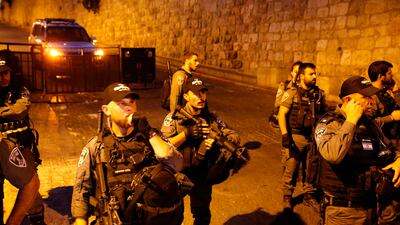Israel's decision to place metal detectors at the entrance to the Al Aqsa Mosque in Jerusalem has inflamed tensions and sparked a wave of violent confrontations between Israelis and Palestinians. Any change to the status quo in the Old City is cast in the media as part of a religious war. But is this latest outbreak of violence really a religious fight or is it instead a flash point in the battle between an occupying power and an occupied people? In the age of ISIL and the historic transformation of the Middle East, occupation doesn't gather nearly the same attention as religious conflict.
Israeli authorities understand the optics all too well. Since 1967, when Israeli forces occupied the eastern part of the city, the Israeli government has invested large amounts of money to annex it. Walls have been built that sever the city from the West Bank, Israeli settlers have moved into Palestinian neighbourhoods and Israel has made life increasingly difficult for Jerusalemite Palestinians. Even municipal services, such as garbage collection in Palestinian areas, are grossly lacking when compared to Jewish Israeli neighbourhoods. The result has been a slow erosion of Palestinian life, which is a fact that is often overlooked in the mainstream press outside the Middle East.
This annexation has been successful despite some international condemnation. It has been so craftily completed, in fact, that extremist movements calling for the Israeli takeover of the Al Aqsa compound have gained significant traction in recent years. The Temple Mount Movement, for instance, now enjoys the support of half the ruling Likud party.
Yet, the rise of extremists who wish to change the status quo in the Old City doesn’t fully explain the recent violence in Jerusalem. To understand what is happening on the ground, we have to take a step back from the conflict and consider events in the region and beyond. From the Israeli government’s perspective, the occupation is thriving and they want to keep it that way.
Israel’s economy continues to improve on the back of its defence industry and booming tech sector. With Donald Trump in the White House, Tel Aviv believes it has a sympathetic American president who will do little in the way of condemnation of its activities against Palestinians. The Middle East is in a state of chaos as the wars in Syria, Yemen and Iraq, as well as the ongoing crisis in Qatar, continue to demand the attention of Arab leaders. As such, Israel has no real price to pay for its occupation of Palestinian land, nor anyone to tell it stop. Thus, it sees no reason to alter its course.
At home, however, Israeli prime minister Benjamin Netanyahu continues to be plagued by scandal, the latest of which involves a possible conflict of interest in the purchase of German dolphin class submarines. There are additional reports that Mr Netanyahu has fallen out of favour with his main benefactor, Sheldon Adelson, a billionaire Las Vegas casino magnate who had helped the Israeli prime minister rise to power.
The decision to install metal detectors at the Al Aqsa compound was taken with the knowledge that it would inflame tensions. According to Israeli press reports, even the military protested the move. And yet, as we have seen in the past from Mr Netanyahu, changes to the status quo have been made with the full knowledge that they would engender violence. But if history is any guide, Mr Netanyahu believes he can use this violence to his advantage.
The clashes serve several key purposes for the Israeli government. They draw attention away from the scandals involving the prime minister by reminding the Israeli public that they are locked in an ongoing battle with Palestinians and by soaking up the majority of rolling news coverage in the country. More importantly, they shift the narrative of the Israeli-Palestinian conflict in the international community back to one about religion instead of occupation and domination. News bulletins around the world flash with headlines about fighting between Israelis and Palestinians over holy sites in Jerusalem, instead of Israel’s ongoing blockade of Gaza or the creation of new Israeli settlements.
Finally, the clashes provide yet another test for the Palestinian leadership in the West Bank. Mahmoud Abbas, the president of the Palestinian Authority, said he would cease cooperation with Israel except with regards to security. As more and more Palestinians take to the streets in protest at the occupation and the annexation of Jerusalem, Mr Abbas is facing a test of how well he can contain his own people. Through security collaboration with Israel, the Palestinian Authority is a critical arm of the occupation. As such, Tel Aviv requires constant assurance that Mr Abbas’s security forces have what it takes to quell popular protests.
This wave of violence might focus on Jerusalem’s holy sites, but it is really about occupation and annexation. Will Palestinians be able to unify, as they have in the past, to create a sustained movement against Israel’s domination over their lives and land? That question remains.

